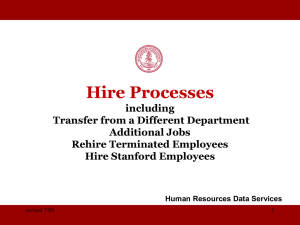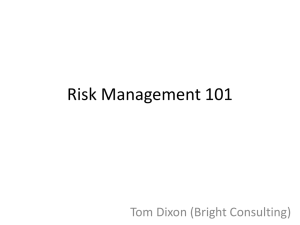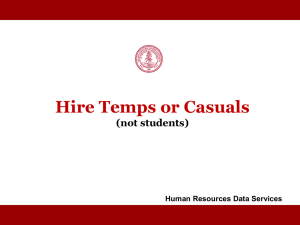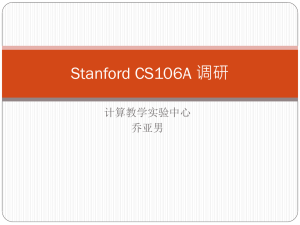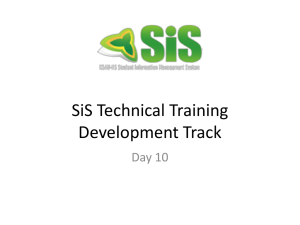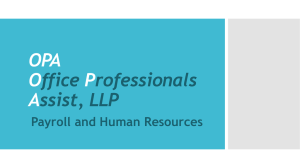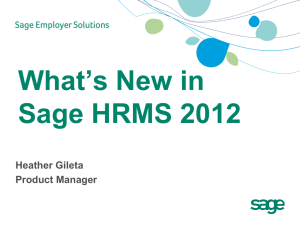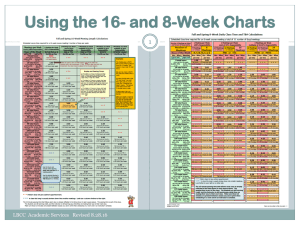Overview: HR Business Process and Policy Training
advertisement
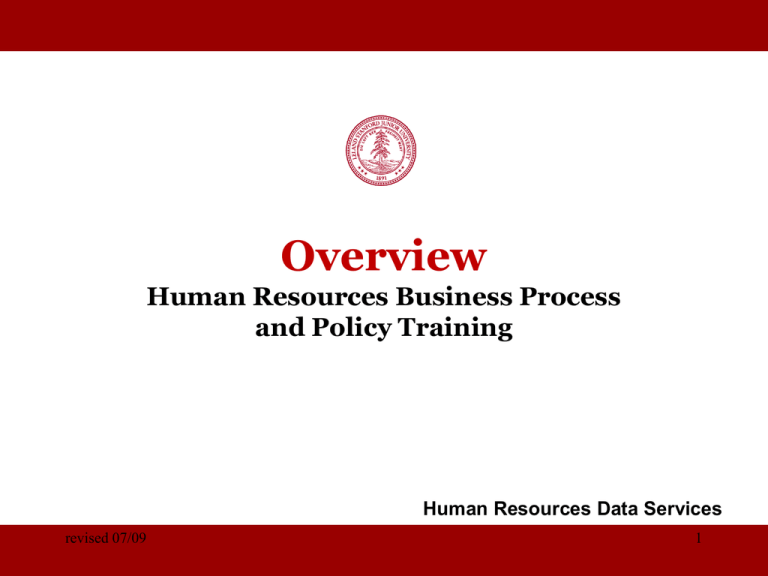
STANFORD UNIVERSITY Overview Human Resources Business Process and Policy Training Human Resources Data Services revised 07/09 1 Topics About this Training HR at Stanford Stanford’s HRMS* PeopleSoft HR Getting Help *Human Resources Management Systems revised 07/09 2 About this Training Scope and Structure Goals Future Hopes revised 07/09 3 Scope and Structure Materials follow general employee life cycle – – – – Hiring Leaves Job Actions Terminations Does not include faculty: contact Faculty Affairs, Lynn Dixon, ldixon@stanford.edu, for faculty training Focus is mostly on Stanford HR polices and practices relating to HRMS Systems – Rely on your HRM and other resources for additional information and training revised 07/09 4 Goals What we hope to accomplish: – – – – – Clarify approach, expectations Articulate sometimes ambiguous processes Develop common language Identify consequences of missing or erroneous information Help you understand interdependencies with PS HRMS and many other systems – Provide the “big picture” for processes so complete process is known, not just steps in system • The system is your tool, used to complete a business goal – The materials you use for training now are your references later revised 07/09 5 Future Hopes We work towards the following: – That our documentation of business processes and associated system job aids are exceptionally clear – That HR Administration at Stanford becomes a model among peer institutions – That state and federal regulatory agencies and international granting agencies consider our reporting to be highly accurate – That those processing HR transactions do not hesitate to ask for help, understanding that many situations are extremely complex revised 07/09 6 HR at Stanford HR Mission Structure Policies Stanford’s Diverse Workforce Confidentiality Compliance Exempts/Non-Exempts, Salaried/Hourly Temps and Casuals revised 07/09 7 HR Mission Statement Human Resources at Stanford supports the University’s mission of excellence in teaching and research through strategic, innovative and flexible policies, practices, programs and services that are: -Fair, ethical and legally compliant; -Foster a productive work environment where people feel valued; -Attract, develop, reward and retain a diverse and talented workforce; and are -Efficient, cost-effective and add value revised 07/09 8 Structure of HR Employee & Management Services Organization Chart at http://elr.stanford.edu/who.html reflects differences between administrative and academic areas Schools and VP areas, and local units, can apply specifics of policies differently, due to diverse types of employees and operational needs List of Human Resources Managers (HRMs) & Human Resources Administrators (HRAs) at http://hrweb.stanford.edu/ Central HR units listed at http://hrweb.stanford.edu/hrdirectory.html revised 07/09 9 Policies The Administrative Guide is a reference manual of University administrative policies – – – – Chapter 2 contains personnel policies Online at http://adminguide.stanford.edu/ch2contents.html Available 24/7 It is your responsibility to be familiar with these personnel policies Other University-wide policies can be found at http://www.stanford.edu/home/administration/polic y.html revised 07/09 10 Stanford’s Diverse Workforce One of the factors that makes HR at Stanford complex is the diversity of its workforce Different federal and state laws, University policies and benefits may apply, based on the employee’s type Because of this, you must use the correct codes in PeopleSoft HRMS Talk to your HRM to learn what type of employees work in your area Become familiar with Administrative Guide Memo 23.1, Definitions, http://adminguide.stanford.edu/23_1.pdf, for all the different types of employees in your area revised 07/09 11 Stanford’s Diverse Workforce Professoriate – See the Faculty Handbook, http://facultyhandbook.stanford.edu/ – If you have faculty in your area, contact Faculty Affairs for training; this training does not cover faculty Non-academic Regular staff employees are eligible for benefits Contingents are not eligible for benefits – Students have a limit on the number of hours they can work each week – Temps & Casuals Bargaining Unit employees are governed by a contract – United Stanford Workers’ contract can be found at http://hrweb.stanford.edu/information/usw.html – Deputy Sheriffs Association Academic Staff – Other Teaching Titles, Research, Librarian Research: if you have employees who do research in your unit, review the Research Policy Handbook at http://www.stanford.edu/dept/DoR/rph/ revised 07/09 12 Confidentiality Review – Personnel Files and Data, Administrative Guide Memo 22.2 (http://adminguide.stanford.edu/22_2.pdf) – Privacy of Health Information (HIPAA), Administrative Guide Memo 23.10 (http://adminguide.stanford.edu/23_10.pdf) Tips – – – – Lock your screen when you step away for a moment Shred confidential materials you no longer need Pick up materials at printers and faxes promptly Don’t talk about HR matters in hallways, bathrooms, or restaurants revised 07/09 13 Compliance The University does Compliance Reporting for – University Board of Trustees and Administrative Officers: basis for decision making – State and federal government: shows we comply with laws and regulations – Granting agencies: regulatory as well as granting stipulations compliance revised 07/09 14 Exempts and Non-Exempts Exempt – Employees may be exempt from the overtime pay and recordkeeping requirements when they occupy bona fide professional, managerial, or executive positions. – At Stanford "exempt“ positions normally are executive officers, faculty, academic staff, other teaching staff, and certain professional, administrative, and executive staff. – "Exempt" status is determined by the Executive Director of Human Resources, in accordance with provisions of the Fair Labor Standards Act (FLSA) and regulations of the U.S. Department of Labor Nonexempt – Employees who are not "exempt" under federal and state overtime regulations. – Must receive compensation for overtime work revised 07/09 15 Salaried and Hourly Salaried – Compensation established by the month with the amount remaining the same each month without regard to the variations from month to month in the normal number of working hours. Hourly – Compensation established on an hourly basis, so that pay varies with the actual number of hours worked (or on paid leave) in each pay period See Administrative Guide Memo 23.1, Definitions, http://adminguide.stanford.edu/23_1.pdf, for more information revised 07/09 16 Temps and Casuals Temporary and casual workers are referred to as “contingent” workers, are not benefits-eligible and no requisition is required to hire them. – Temps are appointed for up to six consecutive months at any percentage of time. If duties are technical, maintenance, or service duties, appointment is for up to four consecutive months at any percentage of time. – Casuals are appointed at less than half-time for up to six consecutive months or longer. If duties are technical, maintenance, or service duties, appointment may be less than half time for four consecutive months or longer. Records must be maintained for temps and casuals as vigilantly as they are for regular employees revised 07/09 17 Stanford’s HRMS HRMS Systems PS HR Manage Positions Role PS HR Expert User Axess Timecard Labor Distribution Payroll Process ReportMart1 STARS (Stanford Training and Registration Systems) revised 07/09 18 HRMS Systems PeopleSoft HRMS PeopleSoft Payroll Axess Timecard ReportMart1 HR STARS Working Partners – Payroll Department in Controller’s Office – Disability & Leave Services (DLS) handles certain disabilityrelated leaves – Labor Distribution in Oracle Financials – PeopleSoft Student Administration (not covered in this training) revised 07/09 19 PS HR Manage Positions Role Position records are managed independently of employee job records The Manage Positions role oversees the creation and maintenance of position records – – – – – Create a new position Update a position Reclassify a staff position View position summary data Careful consideration must be made to determine if a needed transaction requires the position record to be updated, or the employee job record to be updated, or both Ask your HRM who has the Manage Positions role in your area revised 07/09 20 Manage Positions Role Here are two examples of possible changes to records: – 1. The manager of John Doe realizes he has a need to increase the FTE on a position. The position is currently half-time (.50 FTE). He arranges the approvals necessary to increase the position FTE to 100% (1.0 FTE). [FTE = Full Time Equivalent] • This case calls for a change to the position record to increase the FTE, but does not necessarily mean a change to the employee's job record. However, a review of the employee's job record is recommended. • Refer to Update a Position job aid – 2. An employee works 40 standard hours per week and talks to her manager about temporarily reducing her standard hours to 20 in order to handle some personal business. The change is approved. • The position record is not changed, as the approved FTE remains in place. However, the employee's job record must be updated to reflect a decrease in standard hours as well as compensation. • Refer to Employment Update job aid revised 07/09 21 PS HR Expert User Expert Users role are responsible for the creation and maintenance of employee job records, overseeing the hiring process and ongoing management of changes to employee status, including leaves, terminations, pay changes, etc – Responsible for loading the HR transactions Importance of Employee Job Records – PeopleSoft HRMS is the system of record for personnel data • It is the University’s official data repository for inquiries and reporting – Key areas of compliance are related to job records: hires, rehires, leaves, terminations, job changes – Having accurate employee records means having accurate pay and benefits and increases employee trust in their employer revised 07/09 22 Expert Users Use HR Data Services site for job aids, reference guides, training, etc. – http://hrdata/index.html Attend HRMS Users’ Groups (HUG) – Quarterly meetings – Schedule, slides and handouts posted on HR Data Services website (link above) Read the HR Newsletters for updates – Archived on the main HR website http://hrweb.stanford.edu/ revised 07/09 23 Axess Timecard Axess Timecard is Stanford’s Time and Leave Reporting System Roles – Employee • Enter time and leave via the web – Supervisor/Manager • Perform online approval – Time and Leave Administrator (TLA) • Enter Schedules and Edit Time Cards • Verify completion of time records each pay period • Verify that time reported and leave taken are paid consistently with University policy • Maintain accurate and timely leave records • Perform Historical Edits, if applicable revised 07/09 24 Labor Distribution Labor Distribution is an application within Oracle Financials used to distribute payroll earnings paid by the PeopleSoft Payroll system Labor Schedules define how payroll earnings are distributed for a given employee's assignment(s), identifying what percentage of the employee's time is devoted to each of his or her assignments and which PTA's (Project, Task, Award) will pay for them How Labor Distribution Interacts with PeopleSoft HR – PeopleSoft is the system of record for Human Resources. Employees and jobs are set up in PeopleSoft; this information is then loaded from PeopleSoft into Oracle. "Jobs" in PeopleSoft become "Assignments" in Oracle. Labor Schedules are then "attached" to employees' assignments in Oracle – PeopleSoft generates the payroll. The payroll information is then sent to Oracle to be distributed by Labor Distribution to the appropriate PTAs within Grants Accounting in Oracle Financials revised 07/09 25 Payroll Process Stanford pay periods are the – 1st to 15th and 16th to last day of month Takes special coordination and data feeds between – – – – – PeopleSoft HR module PeopleSoft Payroll module Axess Timecard Labor Distribution And other systems Review Payroll deadlines calendar http://financialgateway.stanford.edu/staff/payadmin/res_jobaid.html – You must abide by the transaction deadlines to make all the processes run correctly – You are “locked out” of PS before each period so system interfaces can run Employment Verification – http://financialgateway.stanford.edu/staff/payemployee/emp_veri fication.html revised 07/09 26 Payroll Process The Payroll Process PeopleSoft HR Employee record entered in PeopleSoft (HR data and salary) Manage HR Records Oracle Labor Distribution Sends data to Axess Timecard and Oracle Labor Distribution to create record for new employee Account information entered in employee record Sends an account number to Axess Timecard Labor Scheduler Axess Timecard Time and Leave taken verified and signed off each pay period Sends time and leave data to PeopleSoft each pay period = Pay Check Sends account information to Oracle Labor Distribution via PeopleSoft = Expenditure Statements Time & Leave Administrator Axess Timecard Account information for all hourly staff verified and signed off each pay period Time & Leave Administrator revised 07/09 27 ReportMart1-HR Reporting Tool A web-based system used to access distributed administrative reports, including HR reports, based on information in PeopleSoft HRMS Access summary and list information which can then be displayed on the screen, output to Excel or printed in a variety of formats ReportMart1 is available at https://reportmart1.stanford.edu revised 07/09 28 STARS STARS (Stanford Training and Registration System) is a web application enabling faculty, staff, and visitors to find and register for training Provides management with a centralized Universitywide tracking tool for compliance and training administration Accessible by anyone with a SUNet ID Go to axess.stanford.edu to use STARS Check STAP balances for Staff members revised 07/09 29 PeopleSoft HR Web Forms Users/Workflow Effective Dates History Action/Reason Codes Finding the Right Record: Search Match & RegAdmin Other Critical Fields revised 07/09 30 Web Forms Users/Workflow A Web Form is a request for a PeopleSoft HR transaction Originators enter transaction data into PeopleSoft and identify the approvers – In the Workflow Home, they have the power to recall a transaction while it is pending approval Approvers may approve or return a transaction from the Workflow Home FYI recipients receive an email notification that a transaction has occurred Expert Users load and save the Web Forms – Ability to make changes to the Web Forms revised 07/09 31 Purpose of Web Forms Provide an audit record for HR transactions such as hires, promotions, salary changes, leaves, and terminations Use web-enabled forms with flexibility to meet local needs and support decentralized HR decisions in diverse organizations Promote self-service by providing easy to use forms that do not require extensive knowledge of PeopleSoft The Web Form Originator is the first point in making sure the data is entered correctly The HR Approver reviews the information at the time of approval The Expert User is the final quality check before the transaction becomes a part of the official HR record revised 07/09 32 List of Web Forms Hire Hire Rehire Transfer from a different department Add Employment Instance Temp, Casual, Student hire Employment Update Loads data to the Job Data Component for: Pay Rate Change Change of Position Number (for promotions, etc.) Termination Termination Retirement Leave of Absence Leave of Absence (Paid) Leave of Absence (Unpaid) Return from Leave . Supplemental Pay Requests Supplemental Pay Bonus Retro pay Off Cycle Check Request pay via special check (not paid on normal pay cycle) revised 07/09 33 Effective Dates Every transaction entered in PeopleSoft HRMS will have an Effective Date The action becomes effective starting with the date you enter in the Effective Date field – Example: A leave action with an effective date of 06/30/yy means the leave begins on 06/30/yy. If you want the leave to begin on 07/01/yy, enter that as the Effective Date on the record – Example: If the employees’ last day at work is 7/31/yy, the Effective Date will be 08/01/yy Ask yourself: What is the first day that the employee is to be on this status? The Effective Date is critical for benefits, payroll, and compliance—entering an erroneous Effective Date creates a significant negative impact and is costly and time consuming to fix revised 07/09 34 Effective Date Goes Everywhere Parking & Transportation Oracle Financials Effective Date ID Card Payroll systems Athletics, Libraries revised 07/09 Axess Timecard Benefits administration (health & welfare, retirement, life) 35 Effective Dates for Multiple Transactions Use the next appropriate effective Sequence # when more than one transaction must have the same Effective Date – Example: Release Job Record has effective sequence 0, then change the sequence # to 1 when loading the transfer Web Form A row is inserted for each different type of transaction – Sequence of 0 for first transaction – Sequence of 1 for next transaction with same Effective Date, and so on revised 07/09 36 Retroactive Dates Retroactive Effective Dates are allowed in PeopleSoft Effective Date should be as close to the real Effective Date as possible You can use a Retroactive Effective Date up to the Effective Date of the latest transaction for the record – Example: Reclassification retroactive to 30 days earlier. If the Effective Date on the last row of the record is before 30 days ago, then you can Effective Date the new row for this transaction to 30 days ago • Payroll has already been run for that pay period, so any retroactive transactions that affect pay must be handled via the Supplemental Pay Web form using retro salary or retro hourly revised 07/09 37 History History is maintained on all records – Click “Include History” button – To see all rows of history, click “View All” – If you do not need to see all rows of history, there is no need to click “View All” revised 07/09 38 Add Remarks Remarks should focus on the WHO, WHAT, and WHEN of the transaction WHO authorized it, WHO did the transaction (you): include SUNet ID & phone extension WHAT is the purpose of the transaction WHEN does the transaction become effective Remarks should be added to every transactions revised 07/09 39 Action/Reason Codes Every transaction in PS HRMS must be coded: – WHAT is being done (Action) – WHY it’s being done (Reason) Action/Reason codes are “triggers” to other systems that rely on HR data, so do not guess. Some of the systems that are affected by these codes are: – – – – – – Benefits administration Payroll, including Axess Timecard for time and labor Oracle Financials Parking & Transportation Graduate Financial Support Libraries, Athletics, ID Card Office revised 07/09 40 Action/Reason Codes (cont’d) Action/Reason codes are the most poorly managed aspect of job records and where we have the most risk – Compliance and management reporting depend on accurate Action/Reason codes along with Effective Dates, Job Codes and Organization Codes Job aids are available at http://hrdata/jobaids.html to help you identify and select the correct Action/Reason code for each transaction Consult with your HRM or DFA (Director of Finance and Administration, School of Medicine) if you are unsure revised 07/09 41 Other Critical PS Fields Earn Codes – An important PS field to code the type of earnings for a particular job; directly affects employee pay Organization Codes – PS field of four alpha characters initially entered on the Position Management. – Also referred as DEPT ID Job Codes – A four-digit number in Position Management that identifies each job classification in Stanford's Pay Plan; sets most of the attributes of the position – Values of the above codes are listed at http://hrdata/referenceguides.html revised 07/09 42 Other Critical PS Fields (cont’d) Pay Group – A field initially entered in Position Management which drives key pay and benefits attributes of the position – Pay Group values include: • • • • • • • • • • • • BU1=Bargaining Unit Hourly CSL=Casual Hourly CTS=Contingent Salaried EX1=Exempt Salaried F09= Faculty Paid Over 9 Months F10=Faculty Paid Over 10 Months F12=Faculty Paid Over 12 Months NX1= Non-Exempt Salaried NXH=Non-Exempt Hourly STU=Student Employees TMP=Temporary Hourly Employees VA=Various Unpaid Employees revised 07/09 43 Search Match & RegAdmin Search Match & RegAdmin are the ways you know if the new employee is already in the system ALWAYS conduct Search Match & RegAdmn BEFORE entering any Hire transactions – There are over 100,000 records in PS HRMS – Find out if the person you’re seeking already has an Empl ID and record in the system – Job Aids are available at http://hrdata/referenceguides.html You must update the right record! revised 07/09 44 Reports To Field Purpose – Track supervisor information for EEOC* regulatory reporting – Identify supervisor for review of time and leave in Axess Timecard Reports To field in PS Manage Positions flows to Reports To field in Job Data – Reports To field is located under the Job Information tab – Reports To is a required field for non-academic staff – Reports To field on STF Remarks tab is used for contingent employees *Equal Employment Opportunity Commission revised 07/09 45 Non-Employee Affiliate Pages Non-employee pages in PeopleSoft will be available to enter affiliates, who are not paid by the University, so they can have an Empl ID and the ability to manage Stanford privileges Only those with “Non-Employee Affiliate Data” Role can enter these affiliates into the PS System Examples of non-employee affiliates: lecturer, visiting scholar, visiting professor, instructor, acting professor, consulting professor Examples of possible privileges: SUNet ID, ID card, eligibility for parking permits, access to libraries, access to email and ID mail revised 07/09 46 Resources Resource URL Personnel Policies: Chapter 2 of the Administrative Guide http://adminguide/ch2contents.html HR Data Services website http://hrdata/index.html HRMS Users’ Group (HUG) handouts and schedule at https://hrdata.stanford.edu/hugschedule.html HRMS Communications To hrpeoplesoftusers@lists.stanford.edu (you are added to this list when you get PS HRMS access) HR Directory includes list of HRMs, HRAs, http://hrweb.stanford.edu/hrdirectory.html HelpSU http://remedy-prod.stanford.edu/cgi-bin/helpsu2 Payroll Forms revised 07/09 http://financialgateway.stanford.edu/staff/payadm in/res_jobaid.html 47
